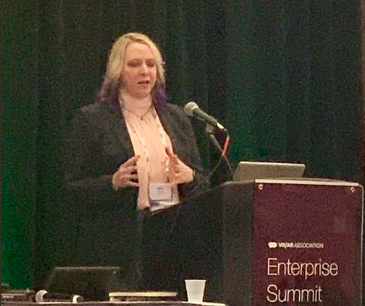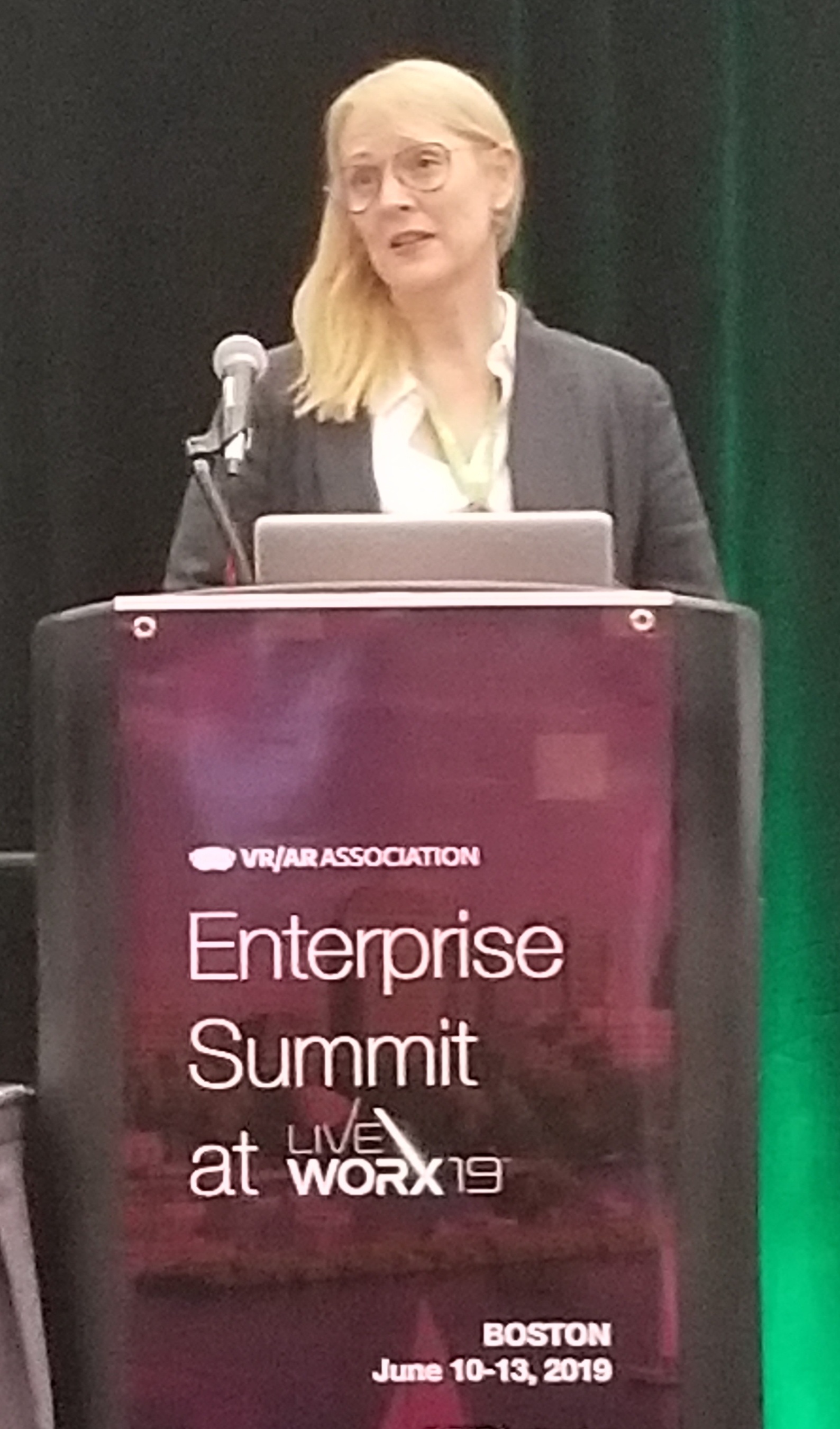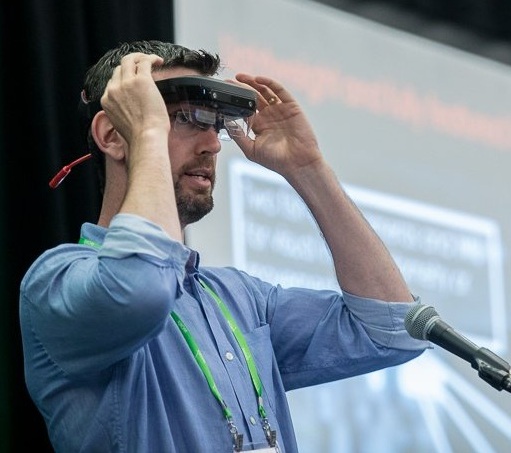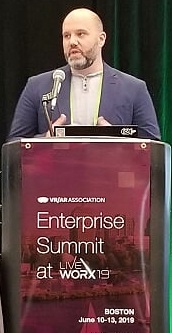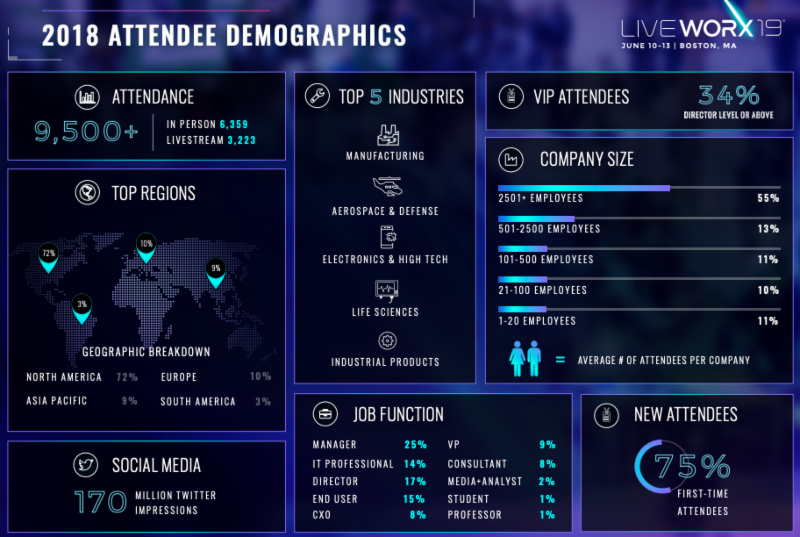Our Storytelling Committee will present the latest case studies, use cases and best practices for how VR/AR is used in Storytelling.
RSVP for our Healthcare Webinar and learn how VR can reduce anxiety based on ISNR review studies!
Recap of VRARA Enterprise Summit at LiveWorx - our Members gave stellar presentations to the industry on the latest Virtual Reality and Augmented Reality Solutions
We invite you to participate in our VR/AR Global Summit Nov 1&2 in Vancouver! More info here
The VR/AR Association (VRARA) partnered with LiveWorx to host the VRARA Enterprise Summit at LiveWorx 2019 at the Boston Convention and Exhibition Center. LiveWorx is the world’s most respected digital transformation conference for the enterprise to experience the most innovative and disruptive technologies — VR/AR, IIoT, machine learning, blockchain, robotics and much more.
VRARA Members had the opportunity to present to some of the top industrial companies from across the globe like Applied Materials, Arcadis, Boeing, ExxonMobil, Franke, Hasbro, Johnson & Johnson, Julabo, Medtronic, Miller & Long, Toro, Sajo, Shell, Siemens, Sprint, Unilever, Zimmer Biomet, Vaillant Group, Verisk. Presentations included topics on AEC, Aerospace & Defense, Energy, Healthcare, Manufacturing, Training.
Kris Kolo of VRARA and Cathy Hackl VRARA’s Board of Advisors & Enterprise Strategy at Magic Leap.
Enterprise VR/AR Spending is expected to reach $13-20B in 2019, and experience a 89% growth to $120B by 2023. So, where are Enterprises spending all of that money? And are they getting the value out of this level of investment in VR/AR? Matt Short of Accenture from our Silicon Valley Chapter shared with us what Accenture is seeing in the market and where their clients are spending the money.
Dan Cotting of Shockoe from our Virginia Chapter gave an excellent overview of strategy for delivering a rapid return on enterprise VR/AR. Dan has worked with clients like Lexus, JB Hunt, Arrow Electronics which has helped shape his beliefs that VR/AR are poised to usher in an entirely new approach to business operations.
Raj Puran, Intel from our Austin Chapter talked about how Intel is driving VR into enterprise and how to overcome the resistance of adopting new technologies.
Marlo Brooke of Avatar Partners from our LA Chapter demonstrated to us an example of how VR/AR is used in the commercial construction industry.
Sivan Iram, Lenovo from our Silicon Valley Chapter demonstrated the newly announced ThinkReality Platform and AR headset from Lenovo, and gave us some great insights!
Frank Black of HTC Vive Enterprise shared with us high-value use-cases from the DoD, Healthcare, and Emergency Response sectors.
Chad Eikhoff of Trick 3D Studios from our Atlanta Chapter along with their customer InterContinental Hotel Group (IHG), discussed an end-to-end enterprise strategy how VR/AR can be used across sales, design, marketing, and design departments in enterprises.
John Cunningham of DiSTI Corporation, from our Orlando Chapter (which is considered to be the Modeling & Simulation Center of the US!) organized an amazing panel on the use of VR/AR in Aerospace.
A fascinating group presentation on healthcare and VR/AR was given by Zimmer Biomet and Precision OS’s Danny Goel, a practicing Surgeon and CEO from our Vancouver Chapter. Together, they are reimagining the educational landscape for health care professionals.
Geof Wheelwright of Atheer, from our SF Chapter and Chair of our Enterprise Committee organized an excellent panel that explored where VR/AR are getting the most traction and how the market has evolved over the last couple of years.
Corporations invested $87B on Training in 2018 and according to Nielsen reports, Enterprises can save 15% ($13B) on Training with VR/AR; VR has retention rates of 75% while traditional methods are only 10%. Jonathan Moss of Sprint Retail Stores and a Member from our Missouri Chapter and Co-Chair of our Retail Committee showed how he’s using VR to train his staff and the ROI benefits. Our Training panel of speakers further discussed VR/AR and Training with additional real-world use cases from Tom Turner of Exxon Mobil and Jay Fraser, HP.
Our AEC specific presentations included Katy Rupp of Ghafari and member from our Detroit Chapter, Aubrey Tucker of ETRO Construction, and a member from our Vancouver Chapter, Vivek Sharma of Magic Leap, and a panel moderated by Mike Festa, VRARA’s Boston Chapter President.
Next we had a Group Presentation focusing on 2 case studies - Siemens Power/Gas & HP Digital Printing and how VR/AR is being used to improve technician and field services.
A recent Gartner report stated "The biggest barrier to the adoption of VR/AR is the lack of good user experience," and Clare Bond of EPAM Systems from our SF Chapter showed us how we can bring experience design to VR/AR.
Thank you again to our Summit sponsors!
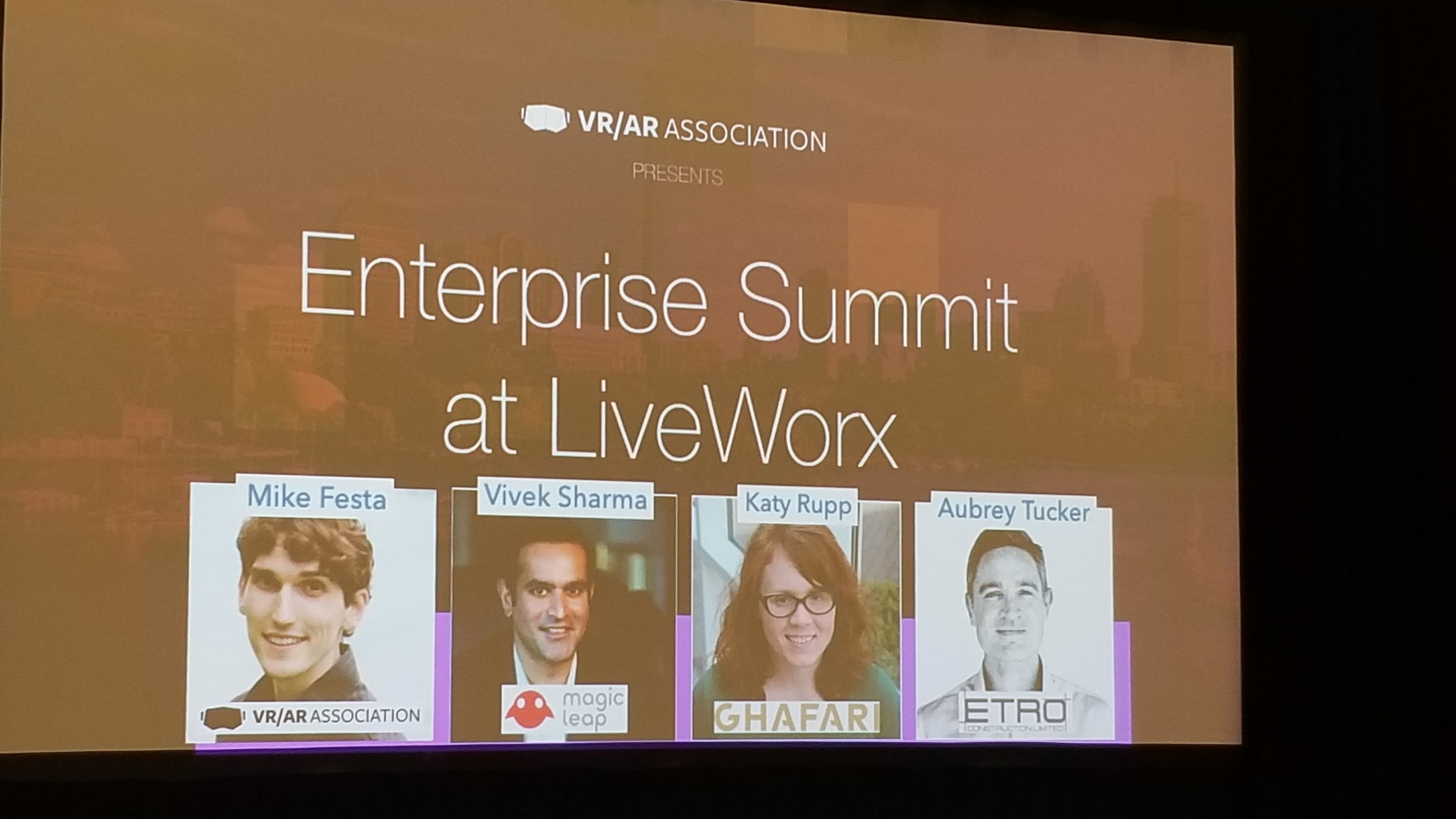
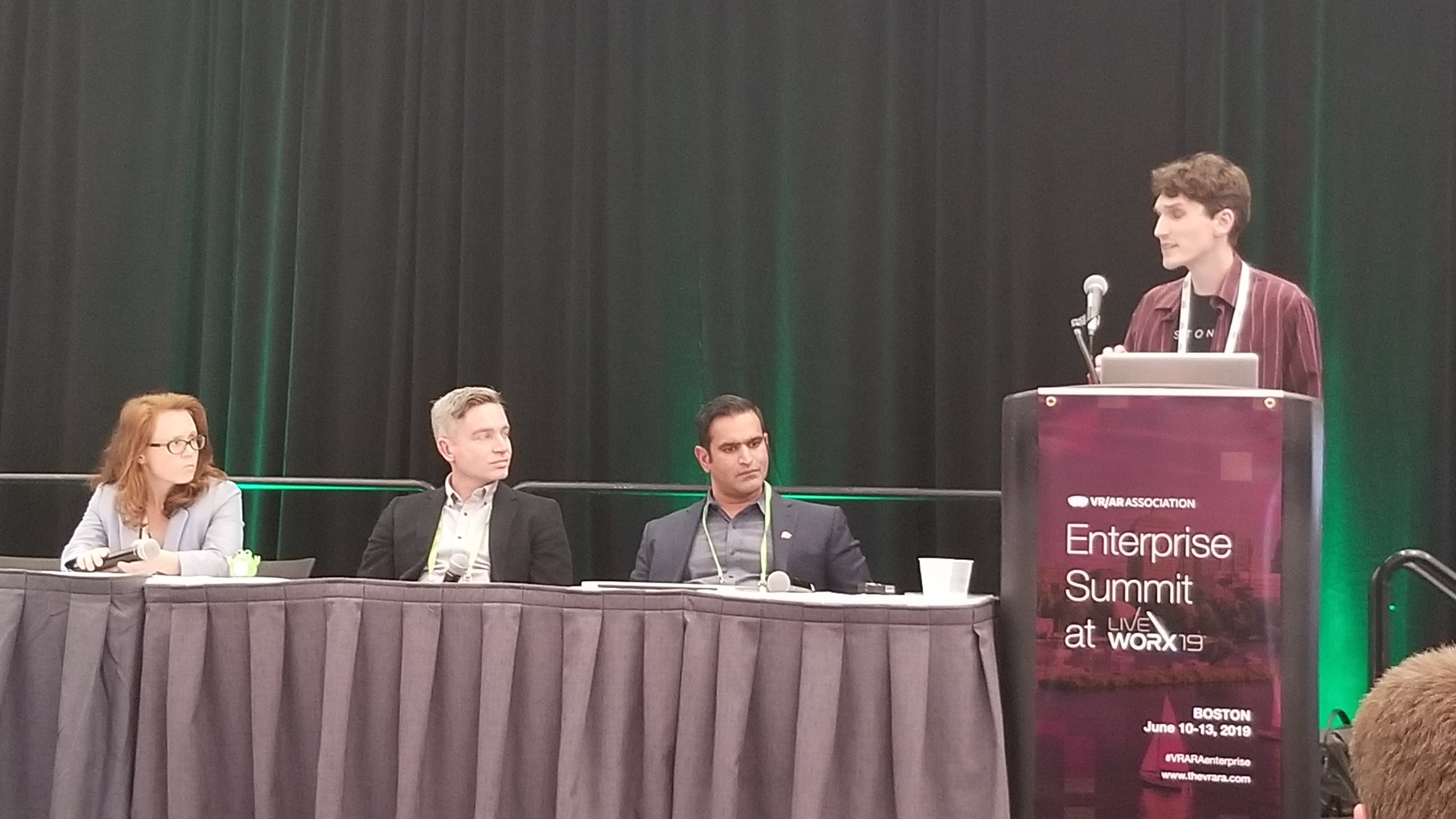
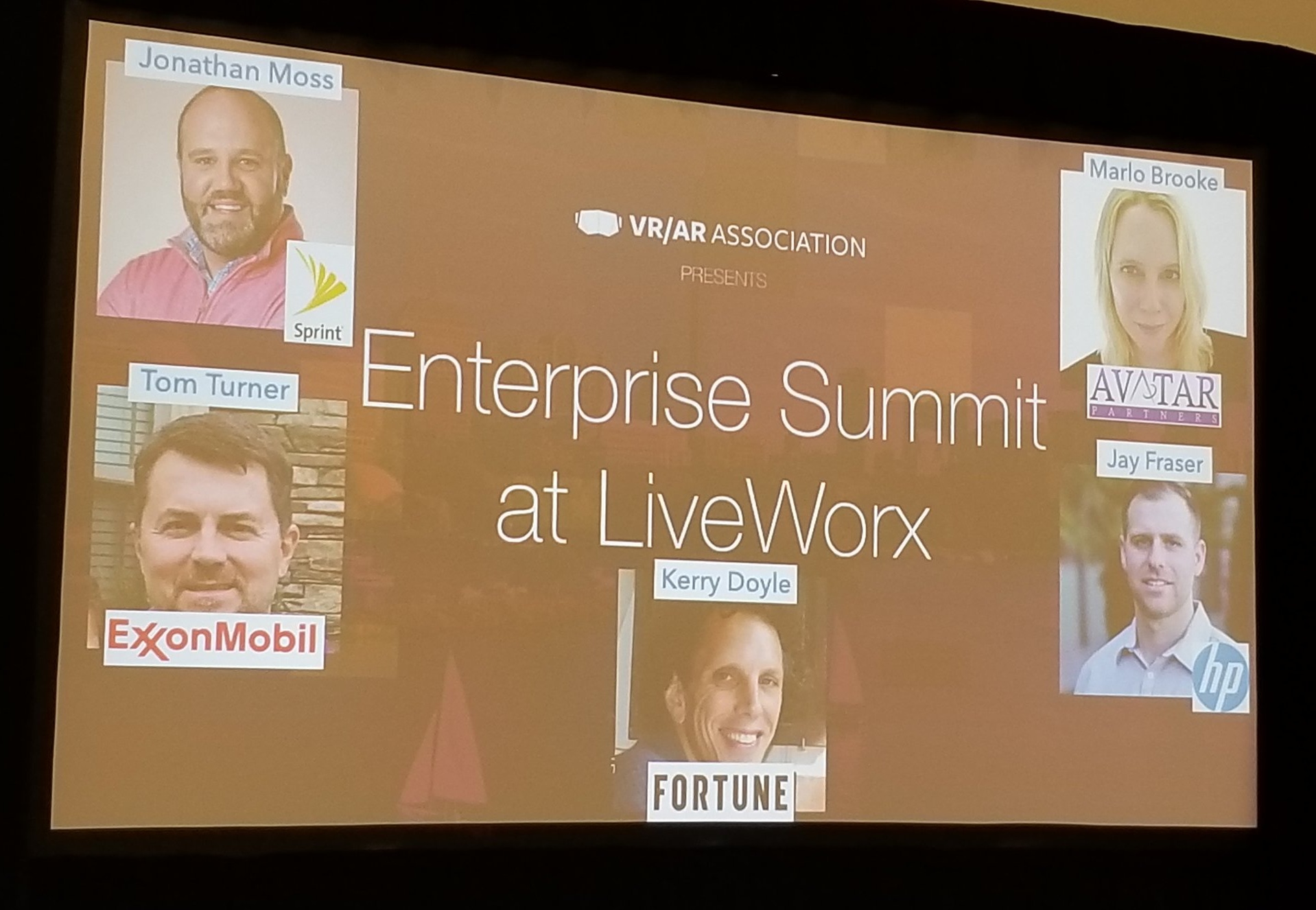
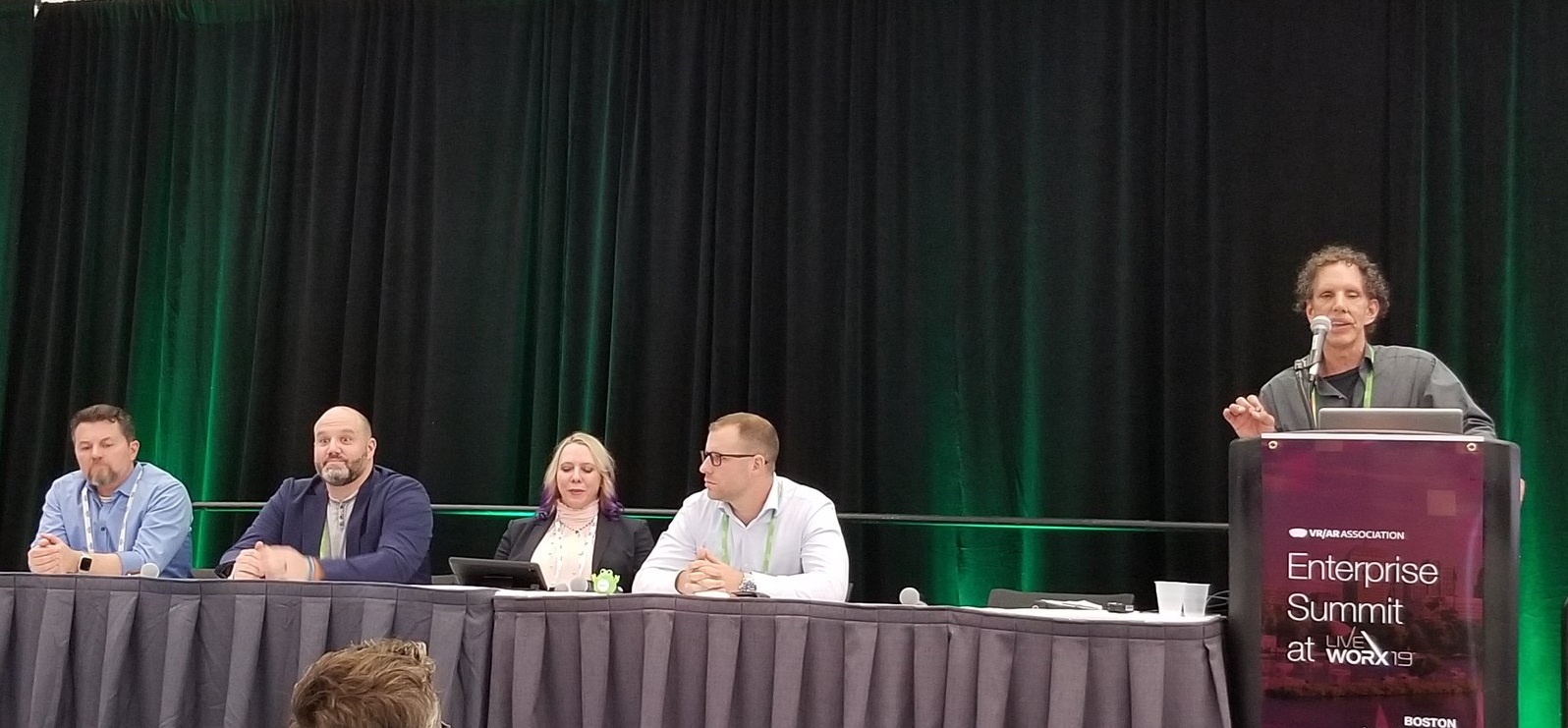
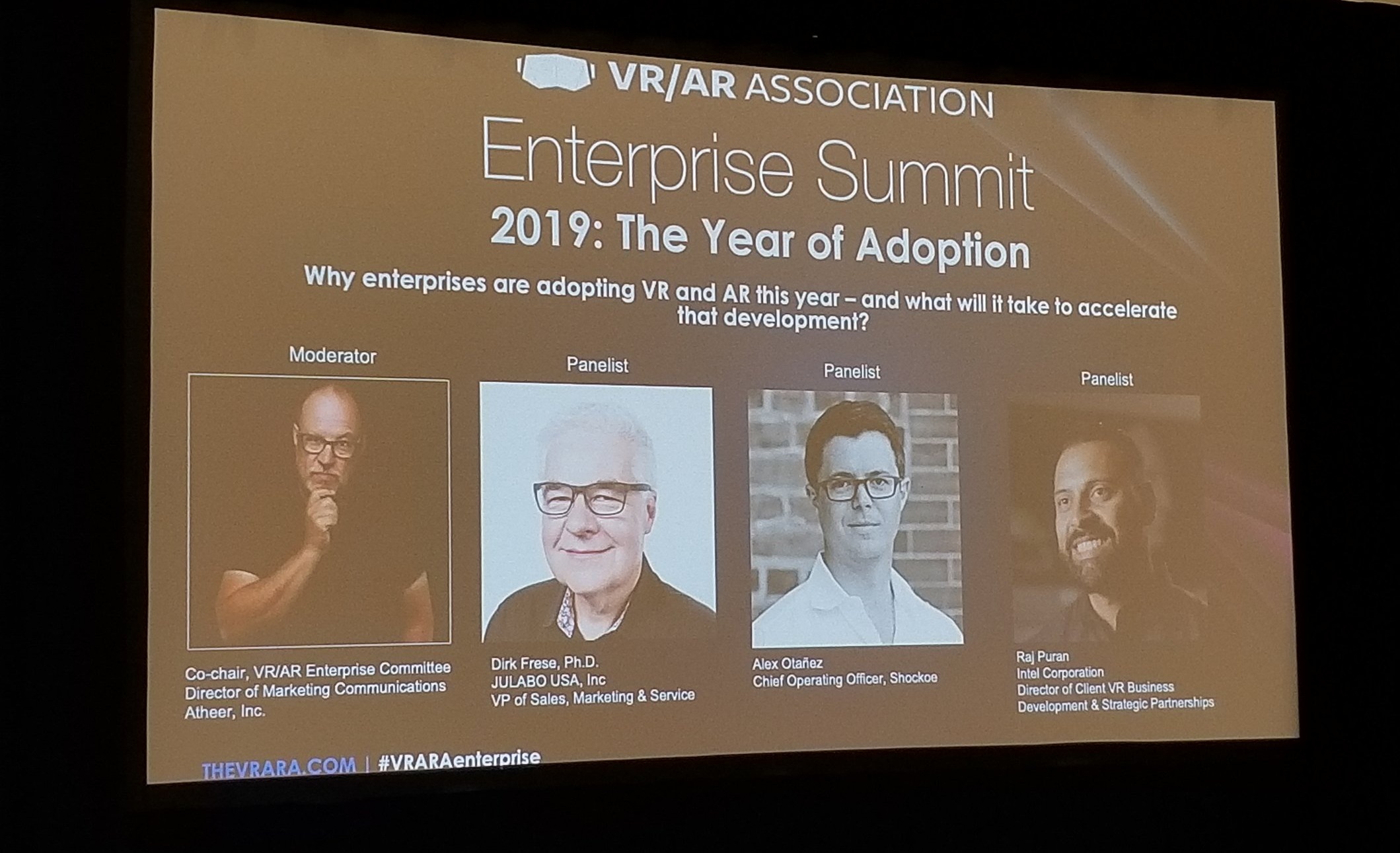
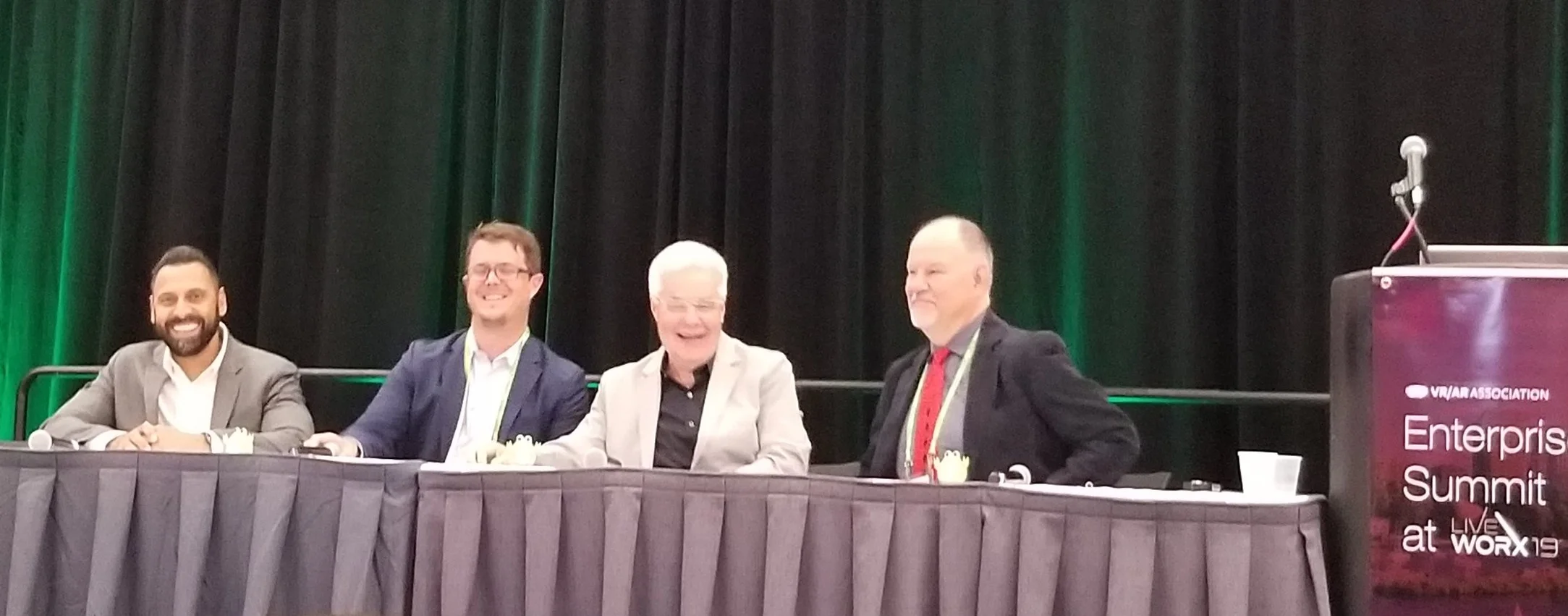
We invite you to participate in our VR/AR Global Summit Nov 1&2 in Vancouver! More info here
Companies participating at our VRARA Enterprise Summit at LiveWorx June 10th. You can still save $800 for LiveWorx June 10-13
Get tickets here!
The VRARA Enterprise Summit at LiveWorx starts next week on Monday, June 10th, taking place at at the Boston Convention and Exhibition Center. LiveWorx is June 10-13. With our Summit ticket, you save $800 on the LiveWorx All-Access-Pass (4 days)!
Our Summit will bring together the best minds in VR/AR from across the globe. Presentations from industry leaders will include topics on AEC, Aerospace & Defense, Energy, Healthcare, Manufacturing, Training, UX & Design, and much more.
LiveWorx is the world's most respected conference for the enterprise to experience the most innovative and disruptive technologies — VR/AR, IoT, machine learning, blockchain, robotics and much more. 6500+ attendees are expected. LiveWorx is June 10-13.
Below are sample of companies attending the Summit and more info about the events:
June 10th at LiveWorx (LiveWorx is June 10-13)
30 Sessions, Panels, Demos. 40 Speakers
Presentations & demos from Accenture, Atheer, Boeing, ExxonMobil, Fidelity, Intel, Julabo, Lenovo, HP, HTC, Magic Leap, Siemens, Sprint, Zimmer Biomet, and others.
Meet executives from Applied Materials, Arcadis, FlightSafety, Franke, Johnson & Johnson, Medtronic, Miller & Long, Toro, Sajo, Shell, Sprint, Unilever, Vaillant Group, Verisk, Whirpool, and other industrial corporations looking for VR/AR solutions!
Networking Lunch, Breaks, and Reception
$800 discount for LiveWorx All-Access-Pass (4 days)!
June 10-13 at the Boston Convention and Exhibition Center
6500+ attendees, 640+ speakers, 240+ sessions, and a 200,000 sq. ft. exhibit hall filled with VR/AR, IIoT, Robotics, and Enterprise solutions.
Demographics from 2018:
Ticket Prices go up May 31st! Register now for our VRARA Enterprise Summit & LiveWorx and save $800! See you June 10-13 in Boston!
June 10th at LiveWorx (LiveWorx is June 10-13)
30 Sessions, Panels, Demos. 40 Speakers
Presentations & demos from Accenture, Atheer, Boeing, ExxonMobil, Fidelity, Intel, Julabo, Lenovo, HP, HTC, Magic Leap, Siemens, Sprint, Zimmer Biomet, and others.
Meet executives from Applied Materials, Arcadis, FlightSafety, Franke, Johnson & Johnson, Medtronic, Miller & Long, Toro, Sajo, Shell, Sprint, Unilever, Vaillant Group, Verisk, Whirpool, and other industrial corporations looking for VR/AR solutions!
Networking Lunch, Breaks, and Reception
$800 discount for LiveWorx All-Access-Pass (4 days)!
June 10-13 at the Boston Convention and Exhibition Center
6500+ attendees, 640+ speakers, 240+ sessions, and a 200,000 sq. ft. exhibit hall filled with VR/AR, IIoT, Robotics, and Enterprise solutions.
Demographics from 2018:
The VR/AR Association Publishes the Universities and Colleges Report with over 40 Institutions that offer Virtual Reality and Augmented Reality Courses and Programs
An educated workforce is a more than a qualified workforce; it is citizenry embracing curiosity. That very curiosity, encouraged by educators, creates the realm of possibility for a thriving, human-centered global populace. Enterprise may develop novel and innovative products with the latest VR/AR and immersive technologies, but without access to a trained, well-educated, and yes, curious workforce, business and industry cannot flourish or compete globally, no matter how cutting-edge or groundbreaking the technologies may be.
The overarching goal of the VRARA Universities and Colleges Committee is to increase higher education’s curiosity and knowledge of VR/AR. We seek to support and promote the bringing together of diverse disciplines, stakeholders, and interest groups within and across institutions in the service of learning both with and about VR/AR.
This report represents the first in a series of steps intended to advance that goal. It provides a high-level overview of over 40 institutions around the world are doing in this space, including:
VR/AR courses and programs being offered;
Use of VR/AR to support learning and teaching in other courses and programs;
VR/AR-related research and development activity being undertaken;
VR/AR in other areas of the institution (e.g., recruitment/ marketing/outreach, libraries, student services).
We hope that the report will be a useful resource for locating expertise, facilitating connections, and building collective capacity among those who are part of the growing community interested in the potential of VR/AR in higher education.
Beyond this report, a further role of the VRARA Universities and Colleges Committee is the coalescing of a higher education– industry alliance aimed at bridging the gap between current educational practices and offerings on one hand, and the emerging workforce needs and demands on the other. To that end, we have recently embarked on an environmental scan of major industry sectors using or otherwise impacted by XR— such as transportation, medicine and healthcare, arts, media and entertainment, and advanced manufacturing—the findings of which will be cross walked to curricular and pedagogical approaches as a means of better understanding how we can prepare students for the jobs and careers of the future.
In the words of Jean Piaget, “the goal of education is not to increase the amount of knowledge but to create the possibilities ... to invent and discover, to create [ people ] who are capable of doing new things.” Join us in our efforts as together, we forge a path for a thriving future of higher education, and of a global workforce enabled by as well as further enabling next-generation VR/AR and immersive technologies.
RSVP for our Fireside Chat with Charlie Fink, Vertigo Games, Schell Games, and Ubisoft. A candid discussion about designing and licensing Games for Arcades
Location Based Entertainment consumer spending is expected to reach $809 million by 2022, but what about from the development perspective…how do business models differ here from the rest of the Games Industry? Are releasing, licensing and creating titles for Arcades really all that much different? And is there a new type of Gamer for whom these titles designed for?
This fireside chat moderated by the LBE Committee’s go to man Charlie Fink, will be asking some of the most recognised Games Studios how they are diversifying their portfolios by offering unique gaming experiences for Out-of-Home Entertainment and how making the move to LBVR compares with developing successful titles for the home consumer market (console, PC, mobile, VR, etc.)?
Schell Games – I Expect You to Die! & Until You Fall
Ubisoft Blue Byte – Escape the lost Pyramid – Assassin's Creed
Vertigo Games – Arizona Sunshine
Tomorrow, join live! Retail Expert Panel featuring Macys, Sephora, Bob's Furniture, Sprint Retail and others!
RSVP here
Our Retail Committee expert panel will present the latest use cases, best practices, and ROI examples. Learn from industry thought-leaders, watch exciting demos of VR/AR solutions currently in the market, and ask questions during our live Q&A.
Tomorrow! Join 200+ during our live webcast, "ROI for VR/AR in Advertising and Marketing + Monetization"
Call for Presenters and Invitation to Participate in our Tourism-Travel Committee and Webinar with Expedia and others
The VR/AR Association Tourism & Travel Committee is inviting speakers for a Webinar we are planning for June. Please email info@thevrara.com if you’re interested to present! Let us know if you’re also interested in Sponsoring this webinar. Our webinars get 200 people attending live, and 1000’s watch the recording.
This committee will create best practices, guidelines, and call to actions (e.g., recommendations for standards) for Travel & Tourism. Specifically, to identify opportunities and accelerate widespread adoption of VR/AR technologies in the travel industry by OTAs, Airlines, Lodging, DMOs and other Travel companies, for marketing, branding and enhancing the user experience through each phase of the traveler journey (dream, plan, shop, book, pre-trip and post-trip)
Join our Committee and representatives from airports, travel agencies, service and solution providers!
Regards,
Darshan Lama, Expedia
Craig Vezina, Realcast
VRARA Co-Chairs
The VR/AR Association issues an Open Call for Companies to participate in the VR/AR Enterprise Industry Sector Report
Fill out this form if you are interested in being featured (VRARA and non-VRARA Members are welcomed if you are a B2B company with a VR/AR solutions or services) and email info@thevrara.com if you would like to Sponsor this report
This industry report will feature companies specializing in VR/AR for B2B Enterprise solutions. The report will be published in June and will be promoted to the industry globally via our Newsletter (25K emails), Website (20K monthly visitors), and at our Global Summits, and via our partners’ networks.
Foreword
by Geof Wheelwright, Co-Chair, VR/AR Enterprise Committee
We are in an industry that most major analysts agree is growing fast. According to a December 2018 report from International Data Corporation (IDC), worldwide spending on augmented reality and virtual reality (AR/VR) is forecast to be nearly $20.4 billion in 2019.
This number is part of a five year growth prediction by IDC spanning the 2017 to 2022 period forecasting that worldwide spending on AR/VR products and services will achieve a five-year compound annual growth rate (CAGR) of 69.6%. And IDC is not alone in making this kind of prediction.
According to Gartner Distinguished VP Analyst Matt Cain, the use of VR and AR are one of six top technology workplace trends that will drive the digital workplace. “Immersive technologies, such as augmented and virtual reality, are ready for mainstream businesses,” he predicts in a March 2019 story that discusses evolving workplaces.
Meanwhile, research firm SuperData (a Nielsen company), recently concluded that enterprises adopting XR training technology (covering Augmented Reality and Virtual Reality) will save $13.5 billion that would otherwise have been spent on traditional training that includes instructors, dedicated learning spaces and traveling to remote facilities.
Another big story lies in where AR and VR are being rolled out. AR. in particular, has a strong mobile story - with analyst predictions suggesting that it will only grow stronger in the coming years. According to a recent story in AR Insider - also quoting recent SuperData numbers - there has been tremendous growth in the development of Mobile AR apps, particularly for iOS mobile devices.
Mobile AR applications are not, however, primarily driven by enterprise needs - but the steep growth in overall app development for ARCore and ARKit - reflects the massive installed base and opportunity they represent for enterprise AR developers.
There are plenty of other examples and predictions that demonstrate the importance of VR and AR to forward-thinking enterprises in the immediate future. The real story right now, however, may be in the “second wave” of adoption that will come in behind the first wave of adoption we are seeing now.
There will always be companies that have the budget, interest and bandwidth to conduct pilots and do field trials of potentially useful technologies. And those have been the primary enterprise customers for VR and AR technologies over the past couple of years.
We are now, however, on the cusp of a moment where the successful trials (and increasing number of deployments) of VR and AR in enterprises are getting the competitors of early adopters companies to start recognizing that they may be missing out on the real strategic advantage they can achieve.
The range of companies you’ll see in this report - and the kinds of customers they serve - are a great example of how impactful their VR and AR solutions have become to enterprise customers. A quick look through this list also makes it clear just how targeted many of these companies are, with products and services often aimed squarely at specific industries.
Just consider the range of applications on offer (and the sectors they aim to serve):
Virtual meeting room technology from Ireland’s meetingRoom.io, which counts the Bank of Ireland among the enterprise customers for its low bandwidth remote work platform.
Spiral Technologies, a company that uses Mixed Reality technology to deliver a solution for the aerospace industry that is aimed squarely at the MRO (maintenance, repair and overhaul) market. The company’s solution provides remote calls and video streaming, object recognition, display of static information, interactive voice assistance and 3D visualisation.
Apprentice.io, which aims its AR-based solution at lab, line and suite environments, with extensive specialization in pharma and biotech industries. The company says its solution is used to empower scientists, engineers and manufacturers who operate in various complex, compliance-driven environments
900lbs, a creative agency and innovation lab offering VR/AR/MR experiences, with an impressive enterprise customer list that includes PepsiCo, Royal Caribbean Cruise Lines, Shell, NTT Data, Bell Helicopter, DXC Technologies, Perot Museum of Nature and Science and Activision/Blizzard.
Dimension10, a company that aims squarely at meeting the needs of industries such as oil and gas, architecture, engineering and construction - where three-dimensional models in VR can deliver real value. Enterprise customers include Skanska, ÅF Group, Aker BP, Framo, NTNU and AF Gruppen.
Atheer, a pioneer in the development of the Augmented Reality Management Platform, with customers in the automotive, aviation, manufacturing and logistics sector. Customers include Porsche Cars North America, which says it has shortened service resolution times at its dealerships by up to 40 percent through the use of Atheer’s AR platform.
Frozen Mountain, which brings live streaming to AR and VR devices in the enterprise. The company provides the software, tools, and professional application development services that enable the delivery of multi-party ultra-low latency live video and data streaming.
vSpatial is designed to be a virtual reality workspace that connects users to their computer applications and coworkers. It allows virtual office collaboration using a VR headset while providing access to popular productivity applications.
VR Vision is a XR (Extended Reality) company that provides immersive technology training platforms for use across multiple vertical markets, including healthcare therapy as well as hospice and retirement homes. The company counts Toyota, Siemens, Thales, the University of Toronto and Alchemy Systems amongst its customers.
Viewpointsystem, a Vienna-based company with two decades of experience in eye-tracking technology, has made eye-tracking the centerpiece of its latest product:.the new “VPS 19” smart glasses that consist of Eye Hyper-Tracking glasses, a separate Mixed Reality click-on (that includes a waveguide display and is placed in front of the lenses) and a pocket-sized intelligent hardware component called the Smart Unit.
MeetinVR, as the name suggests, is a company all about using VR to empower and enhance enterprise collaboration. The company's public roadmap for VR hardware support includes Vive, Oculus Rift, Oculus Quest, Oculus Go and Windows Mixed Reality.
— Geof Wheelwright, Co-Chair, VR/AR Enterprise Committee
Companies already included in the Report include:
Apprentice.io
Atheer
meetingRoom.io
Spiral Technology
EndeavorVR
900lbs
Dimension10
Frozen Mountain
Tech Guilds
vSpatial
VR Vision
Viewpointsystem
MeetinVR
VRgineers, Inc.
NextReality
Plus, 100+ Companies are listed in our Directory)
Fill out this form if you are interested in being featured (VRARA and non-VRARA Members are welcomed if you are a B2B company with a VR/AR solutions or services) and email info@thevrara.com if you would like to Sponsor this report
The VR/AR Association publishes the AR Cloud White Paper
Members: download it from our Members GDrive or email info@thevrara.com
Introduction
The world is moving towards a fundamental shift where our physical reality will soon blend with a virtual one. This idea opens up an entirely new frontier in which our experiences and our realities will be extended in ways we could have never imagined. In this near future, the possibilities for AR are endless.
Brands can attract and engage customers with more immersive and interactive experiences not bounded by physical constraints. Employees can learn how to operate equipments more effectively in complex assembly lines, reducing cost and risks for businesses. Students can visualize complicated diagrams in 3D, improving academic performance. Consumer products, instruction manuals and textbooks are just a small fraction of static objects that can be brought to life.
For mass adoption of AR to occur, content must persist in the real world across space, time and devices. The 3D virtual art will “live” in that space as if it’s really there and will not disappear between different app sessions. Multi-user, occlusion are two additional functions that are key to augmented reality adoption. To enable these abilities and a streamlined experience, the “AR Cloud” is needed.
Authors:
Alex Chuang, Shape Immersive
Amy LaMeyer, EnteringVR
Colin Steinmann, Bent Image Lab / youAR
Gabriel Rene, VERSES
Mikko Karvonen, Immersal
Sam Beder, Ubiquity6
Steven Swanson, VERSES
Contributors:
Matt Miesnieks, 6d.ai
Kris Kolo, VRARA
Table of Contents
1.1 Definition(s) of AR Cloud
1.2 Tech Giants Are Investing in AR
1.3 Building the AR Cloud
2. Use Cases
2.1 Gaming: Niantic
2.2 Indoor Navigation: Immersal
2.3 Productivity: YOUAR
2.4 Social and Gameplay: Ubiquity6
2.5 Events: Geogram
2.6 Location and Tracking: Fantasmo
2.7 AR real estate: SuperWorld
3. Conclusion

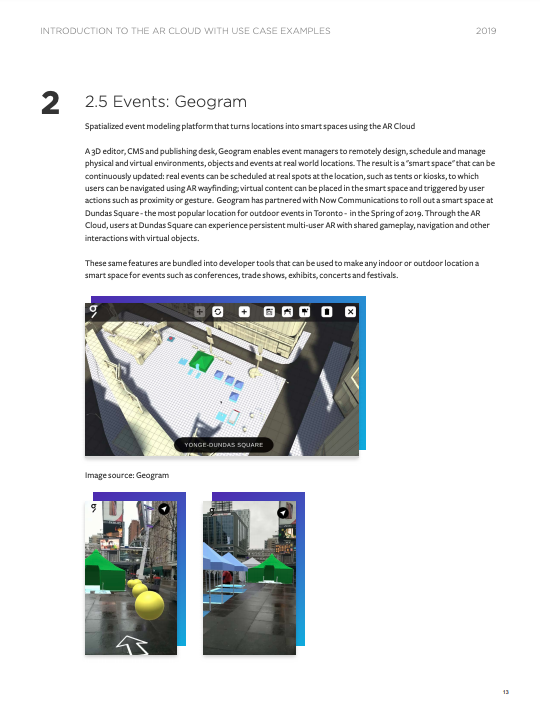
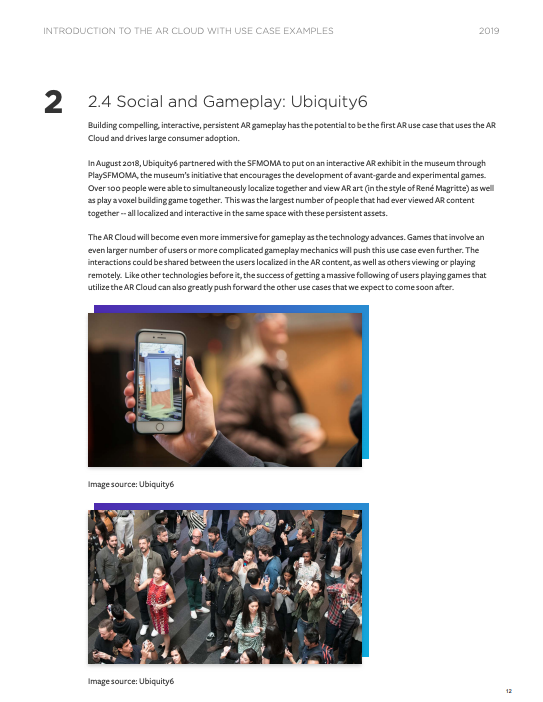
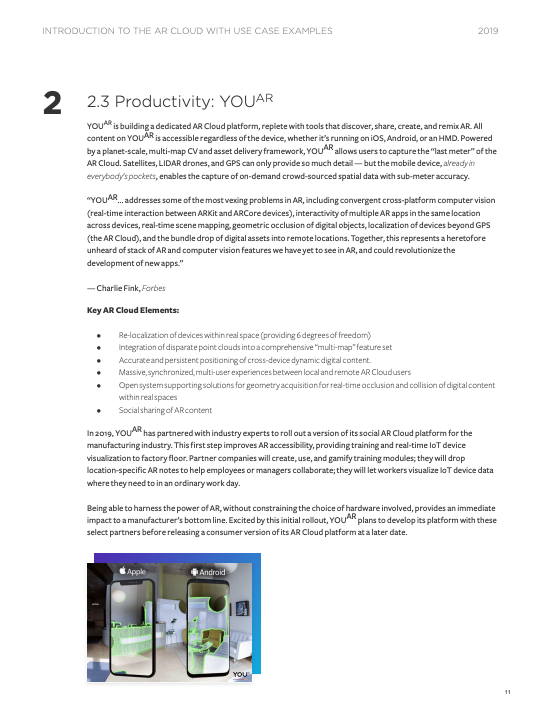
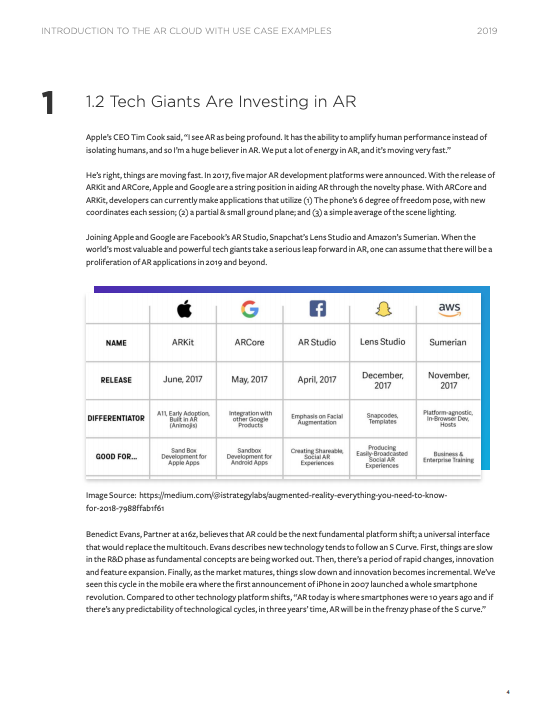
Call for Presenters and Invitation to Participate in our Storytelling Committee Webinar
The VR/AR Association Storytelling Committee is inviting speakers for a Webinar we are planning for June. Please email info@thevrara.com if you’re interested to present! Let us know if you’re also interested in Sponsoring this webinar.
The mission of the Storytelling Committee is creating best practices, guidelines, and call to actions (e.g., recommendations for standards) for Experiences & Storytelling in VR and AR in order to grow the audience (user base) for VR/AR.
In the past, our Committee has presented several webinars (see the recordings here), published a creating best practices, guidelines for VR. See here. We also put together a panel of panel Industry leaders in the storytelling community for the VRARA Global Summit in Vancouver in 2018 .
Join our Committee and representatives from producers and content creators, and other industry leaders.
We also invite you to our next conf call:
Thursday, April 25th⋅11:00 – 11:30am PST or 2pm EST
Join via Hangouts Meet meet.google.com/oua-aukn-aqo
or Join by phone: +1 573-343-8418 PIN: 745 622 962#
Regards,
Jeff Olm & Michael Owen
VRARA Co-Chairs
RSVP for our Webinar: "ROI for VR/AR in Advertising and Marketing + Monetization" expert panel featuring Loreal, Island, WarGaming, King, Snapchat and others
RSVP here
Virtual & Augmented Reality Through the Legal Lens
Notes from VR/AR Association Toronto Chapter meeting March 28, 2019 at Fasken, a top tier law firm with a division focused on the needs of startups and emerging technology companies. Here are some of the ideas that were discussed during this sold-out event.
Start-Up Legal Considerations:
Forming a Corporation — Separate legal entity that will protect you from liabilities to protect founders from loss.
Issuing Founder Shares — Hold shares and guard your equity carefully. What seems like nothing on paper at the beginning (when the company has no value), could end up being millions of dollars when you could have paid thousands to have your proof-of-concept (POC) made. Think about who is really a founder and who isn’t. Create a vesting schedule with well-defined milestones. Offer stock options that allow employees and partners to buy in at a discounted rate. Make sure you have a shareholders agreement (similar to a marriage contract)
People issues — If you have a company, you will have people issues so better to have a clear system for hiring, managing, compensating and removing employees. Work with legal and accounting to decipher whether to use an employee or independent contractor framework to minimize tax implications. Create an employee stock option plan that has a vesting schedule (they earn their shares through time or deliverables). Are the founders' considered independent contractors? Advisory board? Employees? Clearly define the relationships through documentation and ensure deliverables are clear.
Intellectual property (patents) — IP is a tricky thing to plan for as it can create value and protection from competitors, but you have to show your secrets to the world and if you don’t have the resources to protect and defend your IP, what is the point? Are you going to be able to fight Google or Apple if they violate your patent? Patents offer 20-year protection in most places. Inventions must be new and novel. Canada and the US have a ‘first to file’ system. Keeping a ‘trade-secret’ or investing in speed to market may be a better investment in some cases. Co-owners of a patent can sell their share of the patent without the approval of other co-patent holders
Trademark — With trademarks, the design has to be new. Registration of a new trademark is fairly simple and inexpensive and protects you for 10 years. In software, things like unique graphical user interfaces with unique visual properties are protectable (ie. Google’s search screen)
Copyright — Copyrights protect original expression, but have some interesting loopholes that can trip companies up. Who owns the copyright? By definition, the creator of the content owns the rights except in cases where an employee was hired to generate said content and a clearly written transfer of intellectual property and copyright exists.
Contracts (Employees & Contractors)— Contracts with employees and contractors must clearly state who owns the finished products. By default, all IP is owned by contractors who make the product unless stated otherwise. You need a contract with your contractors that they waive all rights to sale.
Contracts (Customers) — Terms of service and End-user License Agreements (EULA) must be clearly written and even though most people won’t read them and they are hard to enforce, you can leverage these in times where liability is opened up (ie. a customer sues you over loss of service, etc.). You need to consider what happens if something goes wrong with your experience. If you have an AR app that takes someone into traffic, they get hit by a car and sue you, does your EULA protect you? Something to consider; you cannot enforce contracts on a minor, but you can put a caveat that they have to state they are over 18. An easier way to manage this is to use a credit card payment thus assuming parental consent.
Product liability — Have you considered the reasonable uses and the effects on the user? Is there a potential risk to the product and how can you mitigate this risk? How can you manage risk in terms of design, terms of use, disclaimer and waivers to cover the relationship.
Insurance — you should have adequate insurance to cover liability for users, directors and officers with proper indemnities to protect the company from attack.
Privacy Policy — The basic idea of privacy is to get consent from users to store, use and share their personal information. The privacy policy should clearly indicate what personal information you are collecting, how you are using it and who you are sharing it with and how. Public perception must by clear and direct privacy terms when commercializing.
Financing — As a startup, you will need to raise capital through any number of ways; Equity (the most expensive), Sales (least expensive), Simple Agreement for Future Equity (SAFE), Convertible Debt (loan). Choosing the right investment vehicle is something for the founders, legal, accounting and strategy teams to decide together.
Virtual, Augmented & Mixed Reality (XR) Industry Specific Questions
Burger King Augmented Reality “Burn That Ad” app Brazil — What are the legal ramifications of defacing a copyright product (poster, billboard, brand)? Who owns the digital space? If ads are in a public space, how can advertisers prevent ad-blockers and other apps that fundamentally change the messaging using AR? How are images used? Depreciating the goodwill of the trademark and infringing on moral rights?
Selling 3D Models of Branded Products — What are the rules/law around 3D models (ie. who owns the rights to a Rolex or Ferrari) that was made from scratch by a 3D artist and sold on sites like www.TurboSquid.com or www.CGTrader.com ?
Who owns Virtual Spaces? — When doing AR activations, what are the ramifications of driving people to public spaces to look at digital content? What about private property? Is the end user responsible for chasing Pokemon in your office building? Do you need permits for public gatherings if done digitally? Is it better to build and execute first and then ask permission later?
How do you apply laws in VR world — Who owns IP in virtual worlds? If I create a virtual world and someone defaces it, what are my legal recourses? Can I kick people out of my virtual space? Is this covered by my terms of service?
How much weight does an NDA hold? — An NDA is only valuable if you have the means to enforce it. If you have an NDA with Google, do you have the means to sue them should they violate it?
Using Law in the courtroom — How can Virtual Reality be used by police and the legal system to provide judges and juries with more immersive looks at crime scenes using laser scanning for accuracy and Matterport or photogrammetry to capture exact scenes for people to look at in VR later.
As you can see if you made it this far, that there are way more questions than answers at this point, which is why it is always important to review with your lawyers and get prudent legal advice before moving forward.
RSVP for our Webinar Expert Panel: Retail Brands using AR/VR technology to help deliver ROI
RSVP here (click on Upcoming tab)
Creating ROI in the future of AR/VR in Retail: How Retailers are using VR/AR to achieve growth, profitability, and customer experience goals. Hear directly from retailers and the tech companies they’re working with to uncover best practices, new technology and new ideas that are shaping the future of how we buy.
Call for Presenters and Invitation to Participate in our 5G Committee
Our 5G Committee is inviting speakers for a Webinar we are planning for May. Please email info@thevrara.com if you’re interested to present! And or let us know if you’re interested in Sponsoring this webinar.
The goal of the VRARA 5G Industry Committee is to pursue VR/AR focused use cases and requirements for 5G networks so as to ensure that the resulting specifications address the needs of this key industry sector.
VR and AR technology holds the promise to fundamentally transform how people interact with and experience the physical world, how they are entertained, and how services are delivered to them. We are at the cusp of this transformation, and, yet, it cannot happen unless the networks that will have to support these applications can deliver the required performance, e.g. latency on the order of several milliseconds. Edge computing is necessary to deliver such performance; while mobile networks, which today already provide pervasive global connectivity, are likely to continue occupying this central role
Join our Committee and representatives from carriers, network providers, and other industry leaders. More info here
Regards,
Alex Reznik, HP Enterprise & ETSI MEC Chairman
Jonathan Moss, Sprint
VRARA Co-Chairs
VRARA Healthcare Committee Mission Statement
The VRARA Healthcare Committee will set industry standards for the meaningful use of immersive technologies.
We are committed to creating and sustaining the conditions that enable all healthcare practitioners to facilitate the transformative power of VR/AR to improve patient care worldwide.
We do this through our commitment to educate and unite healthcare providers around the globe on a single mission to disrupt current standards of care.
The VRARA Healthcare Committee is striving to become the number one network providing invaluable in- depth information for anyone looking to engage VR/AR technology for social impact within the realm of healthcare.
We invite you to participate in our Healthcare Committee! More info here
Regards,
Tim Moyer is the Lead of the XR Lab at Jefferson’s DICE Group. More info here
VRARA Co-Chair









